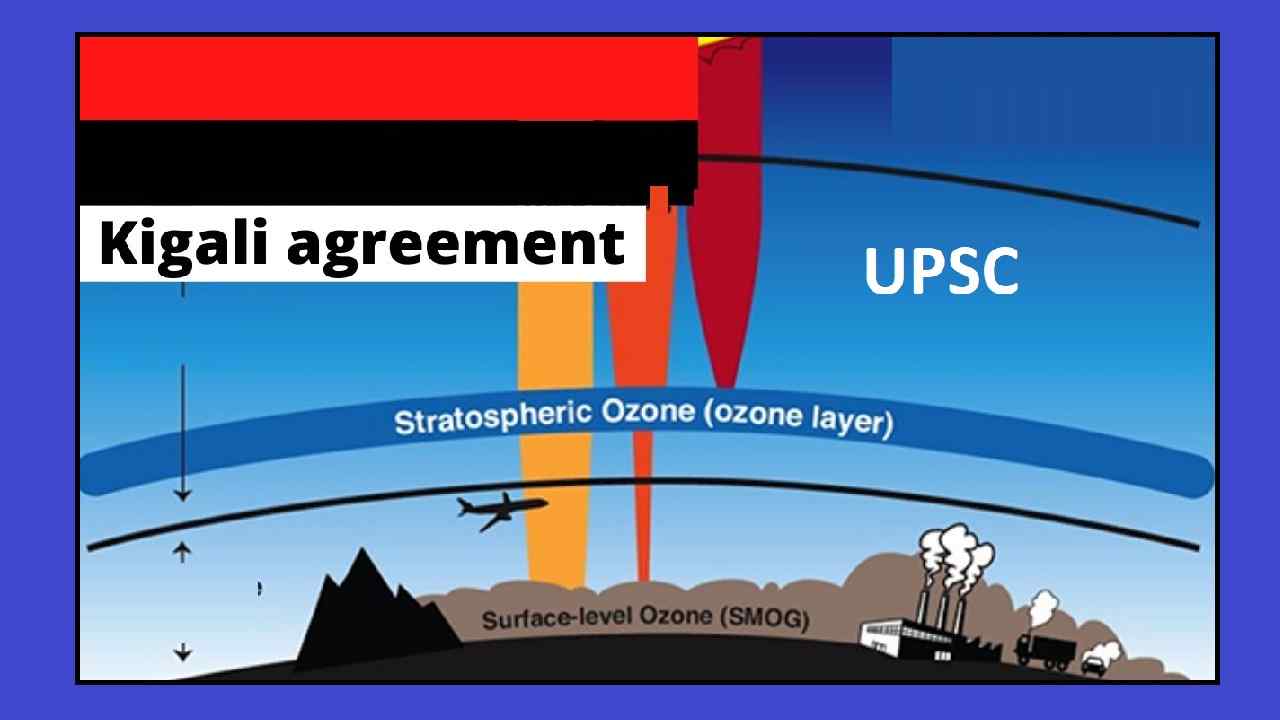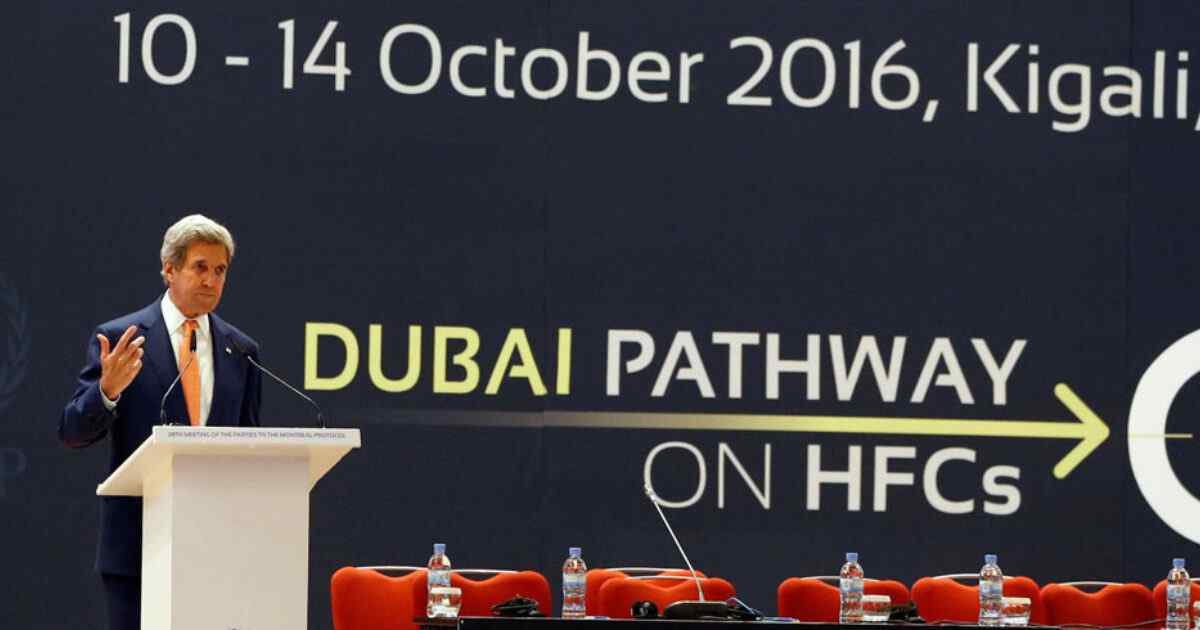
What is Kigali agreement? UPSC Topic
Kigali agreement topic is very important for students preparing for UPSC and governement exams. In this article we have provided you detailed information regarding Kigali amendment, so let's start with-
What is the Kigali agreement?
The Kigali Amendment is a binding public agreement of all parties to the Montreal Protocol that has been in effect since October 2016. Kigali agreement prescribes the timing of the decline in production and distribution of HFCs.
Let us recall that these substances, which are currently used in refrigeration plants, air conditioners, and other refrigeration devices, directly affect the greenhouse effect, since they have a significant global warming potential.
The stages of production snow formation, stipulated by the Kigali amendment, are aimed at reducing the temperature rise of the earth's atmosphere by 0.5 °C.
Developed countries, including the United States and most of Europe, pledge to reduce the use of HFCs by 10% by 2019. The other two groups, representing developing countries, will have to freeze their use of HFCs by 2024 or 2028, before gradually reducing their consumption.

History of the problem
The need to protect the ozone layer led to the development of the Montreal Protocol, an international treaty approved by a number of countries. The terms of the agreement provided for the removal from production and import quotas for a number of substances that have a destructive effect on the ozone layer.
Over the years of its existence, the protocol has been supplemented by numerous amendments, one of which is the so-called Kigali amendment.
HFC vs CFC
CFCs were widely used in the 1980s as refrigerants, solvents and in aerosols. But after the discovery of the famous "holes" in the ozone layer above the poles in 1985, their use was gradually reduced by the Montreal Protocol, which entered into force in 1989, and ratified by 196 countries.
It was necessary to stop the destruction of stratospheric ozone (located between 20 and 50 kilometers above sea level), without which, ultraviolet solar radiation would no longer be absorbed.
Since 2010, they have been totally banned, with the exception of a few well-defined applications.
Since the 1990s, these substances have been gradually replaced by HFCs, which are less stable in the atmosphere and therefore decompose more quickly.
HFCs destroy the ozone layer much less than CFCs, as they are largely destroyed in the atmosphere before reaching stratospheric ozone. But the end of one problem created another that had to be fought.
Indeed, HFCs have a heating power 14,000 times more powerful than CO2, which makes them formidable greenhouse gases. They are therefore in turn gradually eliminated in favor of alternatives: hydrocarbons, carbon dioxide, ammonia, water and hydrofluoroolefins (HFO).
New amendments from 2016
Within the framework of the 28th Meeting, held on October 15, 2016 in Rwanda (Kigali), an agreement was reached between the countries parties to the Montreal Protocol on the need to gradually reduce the consumption of hydrofluorocarbons (HFCs).
This group of substances does not have a pronounced negative effect on the ozone layer. But at the same time, they belong to the group of greenhouse gases with a significant GWP (global warming potential), which is the reason for the phasing out of HFCs.
The need for this measure has been discussed since 2009, and the agreement reached under the amendment is characterized by the following features:
- Reducing the volume of hydrofluorocarbons used in accordance with the established schedule;
- Entry into force of the amendments from January 1, 2019, if the document has been ratified by at least 20 countries;
- The trade in refrigerants belonging to the HFC group will be regulated upon ratification of the amendment by 70 countries.
Kigali agreement- Effort requested from rich countries
The text divides countries into three groups according to the date by which they will have to reduce the use of these industrial gases. The rich countries are called upon to act sooner and faster than the poor.
In the first group, the so-called “developed” countries, including the United States and most of Europe, will have to reduce their production and consumption of FCs by 10% by 2019 compared to 2011 levels. 2013, with this figure expected to rise to 85% by 2036. Many of these countries have already started.
A second group of "developing" countries, including China and African countries, have committed to start the transition in 2024. A 10% reduction from 2020-2022 levels should be achieved by 2029, this reduction to reach 80% by 2045.
A third group of "developing" countries including India, Pakistan, Iran, Iraq and the Gulf countries have pledged to start the freeze in 2028, a decrease of 10% per year. compared to the period 2024-2026 to be reached for 2032, then 85% for 2047.
Timing expected in Kigali agreement
The Kigali Amendment prescribes the volume of reductions in the use of HFCs (in% of the baseline) for countries as follows:
- 2020–2024 - 95% (5% decrease from baseline).
- 2025–2028 - 65%.
- 2029–2033 - 30%.
- 2034–2035 - 20%.
- From 2036 - 15%.
In the early years of the introduction of quotas, significant changes in the refrigeration equipment market will most likely not occur, since the import norms of HFCs are decreasing by only 5% of the total level.
Further adherence to the terms of the amendment will lead to an increase in the rate of decline in the share of hydrofluorocarbons on the market. Based on this, their shortage and a significant rise in prices are likely, therefore, manufacturers will need to gradually switch to alternative refrigerants.
Solution options for Kigali amendment
The forecasted issue of HFC shortages and their possible rise in prices is a problem for refrigeration equipment manufacturers. Freon R-22, which is most in demand on the market, and a number of other substances of the hydrofluorocarbon group, in accordance with the terms of the Kigali amendment, will be gradually withdrawn from circulation. Other multicomponent refrigerants with lower GWP values, in particular R1234yf, R1224yd, R1234ze and others, will begin to be used as an alternative.
At the global level, the solution to the problem should look like this:
- Development of a unified schedule for the phase-out of HFCs by replacing them with alternative freons.
- Transition to HFC substitutes at an outstripping pace, allowing to anticipate a sharp jump in prices, provoked by the rise in production costs.
- Gradual replacement of outdated equipment with new ones.
Related Articales
Recently Posted
-
भगवान गौतम बुद्ध जीवन परिचय | Gautam Buddha in Hindi
December 15, 2022. -
कार्बन के अपररूप Allotropes of Carbon in Hindi
November 5, 2022. -
मिश्र धातु किसे कहते हैं? उपयोग, नाम, गुण Alloy in Hindi
July 27, 2022. -
गलनांक किसे कहते हैं? परिभाषा, उदाहरण Melting Point in Hindi
July 20, 2022. -
परिमाप किसे कहते हैं? Perimeter in Hindi
July 19, 2022.




